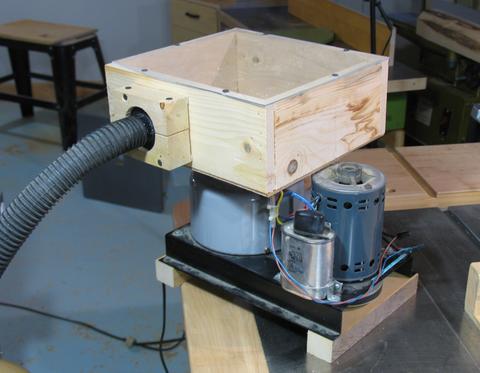 This one is not as well built as my first one. It's just a box of butt joined boards.
It was however the first time I used a brad nailer to build anything (having come across
a free one).
This one is not as well built as my first one. It's just a box of butt joined boards.
It was however the first time I used a brad nailer to build anything (having come across
a free one).
 This one is not as well built as my first one. It's just a box of butt joined boards.
It was however the first time I used a brad nailer to build anything (having come across
a free one).
This one is not as well built as my first one. It's just a box of butt joined boards.
It was however the first time I used a brad nailer to build anything (having come across
a free one).
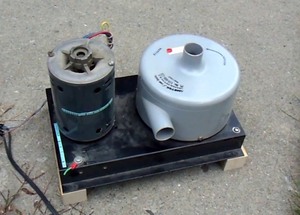 The wasp sucking machine is just a wooden box that fits on top of the intake of
this two stage blower that I bought at a surplus store many years ago.
Air gets sucked out of the bottom of the box through a screen. A shop vac hose attaches
to the side, and a transparent top allows observation of the catch.
The wasp sucking machine is just a wooden box that fits on top of the intake of
this two stage blower that I bought at a surplus store many years ago.
Air gets sucked out of the bottom of the box through a screen. A shop vac hose attaches
to the side, and a transparent top allows observation of the catch.
The blower sucks almost as hard as a shop vac, but is only 1/3 HP. I don't have a dedicated use for it, but it comes in handy for stuff like powering the air engine, or demonstrating crowned pulleys
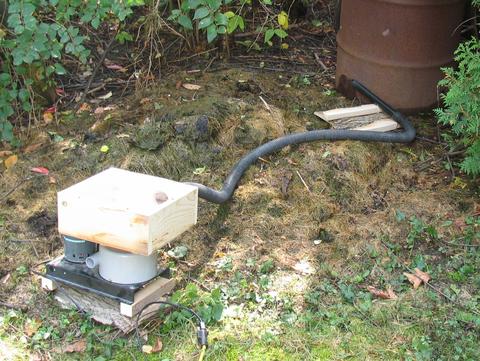 The wasp nest was in the bottom of a steel barrel in my back yard.
The entrance was two small holes at the bottom of the barrel.
The wasp nest was in the bottom of a steel barrel in my back yard.
The entrance was two small holes at the bottom of the barrel.
There's no reason a shop vac couldn't be used for this purpose, but having something that runs quieter, with a window for observation is much more fun. The idea is to leave the machine running for hours and suck in the wasps as they come and go.
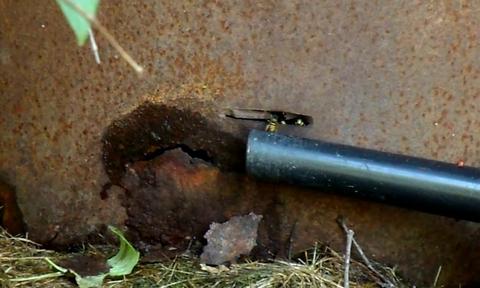 It's not possible to actually suck the wasps out of the nest, but it is possible to suck
them out of the air as they hover near the entrance for a landing.
It's not possible to actually suck the wasps out of the nest, but it is possible to suck
them out of the air as they hover near the entrance for a landing.
Wasps that are just leaving tend to crawl away from the suction before taking off, so the system only works on those returning to the nest.
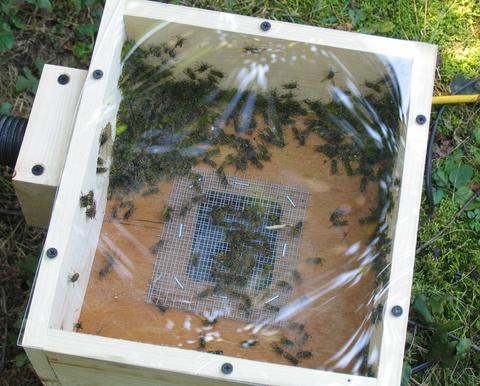 The machine is not very fast, but if left running for hours, makes for a sizable catch.
The machine is not very fast, but if left running for hours, makes for a sizable catch.
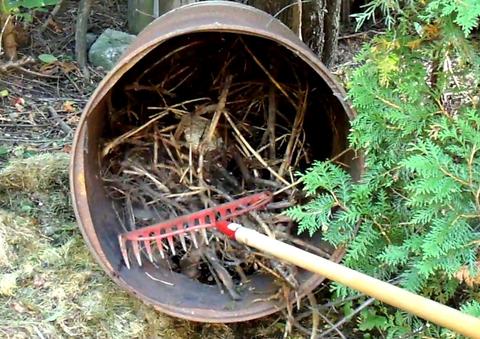 After about four hours, there were very few wasps coming and going from the nest. Even
shaking the barrel didn't get them to come out. So I figured the nest must be fairly
depleted by now.
After about four hours, there were very few wasps coming and going from the nest. Even
shaking the barrel didn't get them to come out. So I figured the nest must be fairly
depleted by now.
So next I tipped the barrel and started pulling at the branches inside to get at the nest. You can see the light gray "ball" shape of part of the nest in this picture.
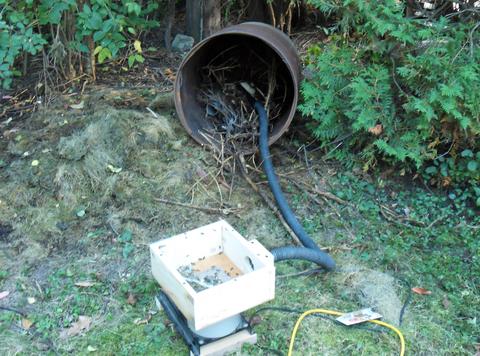 I guess I underestimated how many wasps were left, because suddenly there were quite
a lot of them flying around in and around the barrel. Lucky I didn't get stung.
So I set up the wasp sucker again, this time with the hose near the nest to catch
the remaining wasps.
I guess I underestimated how many wasps were left, because suddenly there were quite
a lot of them flying around in and around the barrel. Lucky I didn't get stung.
So I set up the wasp sucker again, this time with the hose near the nest to catch
the remaining wasps.
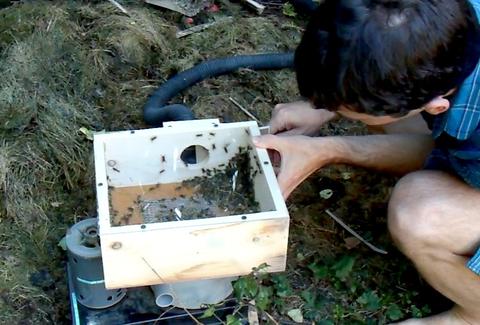 Suction keeps the wasps from getting back out of the trap, but that hole needs to be closed
off before the motor is shut off. I'm sliding a piece of cardboard behind
the hose opening.
Suction keeps the wasps from getting back out of the trap, but that hole needs to be closed
off before the motor is shut off. I'm sliding a piece of cardboard behind
the hose opening.
 Without the constant wind, the catch livened up considerably.
Without the constant wind, the catch livened up considerably.
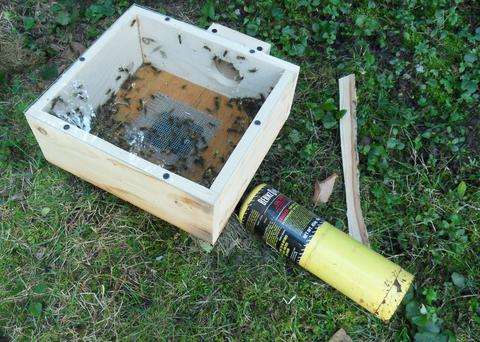 Next question is, what to do with the wasps. A box full of wasps could be material
for some nasty practical jokes. But I just wanted them dead.
I tried to gas them with MPS gas (brazing fuel). It seemed like it was killing
them, but once the gas cleared, they livened up again.
From past experiments, I knew a few drops
of acetone in the box would do it, but I didn't have any acetone. So next I tried
a teaspoon of paint thinner. That did the trick, though not as fast acting as
the acetone was.
Next question is, what to do with the wasps. A box full of wasps could be material
for some nasty practical jokes. But I just wanted them dead.
I tried to gas them with MPS gas (brazing fuel). It seemed like it was killing
them, but once the gas cleared, they livened up again.
From past experiments, I knew a few drops
of acetone in the box would do it, but I didn't have any acetone. So next I tried
a teaspoon of paint thinner. That did the trick, though not as fast acting as
the acetone was.
I wanted to dissect the nest without the wasps, but decided to leave that to the next day to make sure it was abandoned. But with the nest exposed, and no wasps to protect it, the wildlife got to it before I could, and the whole nest was gone by the next morning.
I also discovered that the screen I used at the bottom of the box was too coarse and some wasps made it through. Those all got ground up in the blower, and I had to take it all apart to clean it up. Ground up wasps smell really bad!
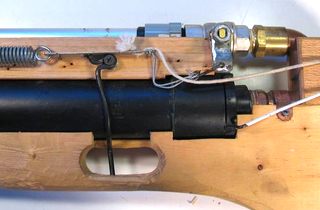 Homemade marble
Homemade marble